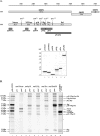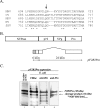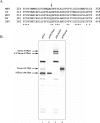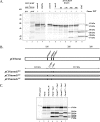Cleavage map and proteolytic processing of the murine norovirus nonstructural polyprotein in infected cells
- PMID: 16873239
- PMCID: PMC1563789
- DOI: 10.1128/JVI.00532-06
Cleavage map and proteolytic processing of the murine norovirus nonstructural polyprotein in infected cells
Abstract
Murine norovirus (MNV) is presently the only member of the genus Norovirus in the Caliciviridae that can be propagated in cell culture. The goal of this study was to elucidate the proteolytic processing strategy of MNV during an authentic replication cycle in cells. A proteolytic cleavage map of the ORF1 polyprotein was generated, and the virus-encoded 3C-like (3CL) proteinase (Pro) mediated cleavage at five dipeptide cleavage sites, 341E/G342, Q705/N706, 870E/G871, 994E/A995, and 1177Q/G1178, that defined the borders of six proteins with the gene order p38.3 (Nterm)-p39.6 (NTPase)-p18.6-p14.3 (VPg)-p19.2 (Pro)-p57.5 (Pol). Bacterially expressed MNV 3CL Pro was sufficient to mediate trans cleavage of the ORF1 polyprotein containing the mutagenized Pro sequence into products identical to those observed during cotranslational processing of the authentic ORF1 polyprotein in vitro and to those observed in MNV-infected cells. Immunoprecipitation and Western blot analysis of proteins produced in virus-infected cells demonstrated efficient cleavage of the proteinase-polymerase precursor. Evidence for additional processing of the Nterm protein in MNV-infected cells by caspase 3 was obtained, and Nterm sequences 118DRPD121 and 128DAMD131 were mapped as caspase 3 cleavage sites by site-directed mutagenesis. The availability of the MNV nonstructural polyprotein cleavage map in concert with a permissive cell culture system should facilitate studies of norovirus replication.
Figures







Similar articles
-
The p4-p2' amino acids surrounding human norovirus polyprotein cleavage sites define the core sequence regulating self-processing order.J Virol. 2014 Sep;88(18):10738-47. doi: 10.1128/JVI.01357-14. Epub 2014 Jul 2. J Virol. 2014. PMID: 24991013 Free PMC article.
-
In vitro proteolytic processing of the MD145 norovirus ORF1 nonstructural polyprotein yields stable precursors and products similar to those detected in calicivirus-infected cells.J Virol. 2003 Oct;77(20):10957-74. doi: 10.1128/jvi.77.20.10957-10974.2003. J Virol. 2003. PMID: 14512545 Free PMC article.
-
Processing map and essential cleavage sites of the nonstructural polyprotein encoded by ORF1 of the feline calicivirus genome.J Virol. 2002 Jul;76(14):7060-72. doi: 10.1128/jvi.76.14.7060-7072.2002. J Virol. 2002. PMID: 12072506 Free PMC article.
-
Proteolytic processing of sapovirus ORF1 polyprotein.J Virol. 2005 Jun;79(12):7283-90. doi: 10.1128/JVI.79.12.7283-7290.2005. J Virol. 2005. PMID: 15919882 Free PMC article.
-
[Genomic organization of Norwalk-like viruses and functions of viral gene products].Nihon Rinsho. 2002 Jun;60(6):1155-64. Nihon Rinsho. 2002. PMID: 12078089 Review. Japanese.
Cited by
-
Protruding domain of capsid protein is necessary and sufficient to determine murine norovirus replication and pathogenesis in vivo.J Virol. 2012 Mar;86(6):2950-8. doi: 10.1128/JVI.07038-11. Epub 2012 Jan 18. J Virol. 2012. PMID: 22258242 Free PMC article.
-
Inherent structural disorder and dimerisation of murine norovirus NS1-2 protein.PLoS One. 2012;7(2):e30534. doi: 10.1371/journal.pone.0030534. Epub 2012 Feb 7. PLoS One. 2012. PMID: 22347381 Free PMC article.
-
Antiviral strategies to control calicivirus infections.Antiviral Res. 2010 Aug;87(2):162-78. doi: 10.1016/j.antiviral.2010.05.002. Epub 2010 May 21. Antiviral Res. 2010. PMID: 20471996 Free PMC article. Review.
-
Complete Genome Sequence, Molecular Characterization and Phylogenetic Relationships of a Temminck's Stint Calicivirus: Evidence for a New Genus within Caliciviridae Family.Microorganisms. 2022 Jul 29;10(8):1540. doi: 10.3390/microorganisms10081540. Microorganisms. 2022. PMID: 36013958 Free PMC article.
-
Akt Plays Differential Roles during the Life Cycles of Acute and Persistent Murine Norovirus Strains in Macrophages.J Virol. 2022 Feb 9;96(3):e0192321. doi: 10.1128/JVI.01923-21. Epub 2021 Nov 17. J Virol. 2022. PMID: 34787460 Free PMC article.
References
-
- Al-Molawi, N., V. A. Beardmore, M. J. Carter, G. E. Kass, and L. O. Roberts. 2003. Caspase-mediated cleavage of the feline calicivirus capsid protein. J Gen. Virol. 84:1237-1244. - PubMed
-
- Ando, T., J. S. Noel, and R. L. Fankhauser. 2000. Genetic classification of “Norwalk-like viruses.” J. Infect. Dis. 181(Suppl. 2):S336-S348. - PubMed
-
- Belliot, G., S. V. Sosnovtsev, T. Mitra, C. Hammer, M. Garfield, and K. Y. Green. 2003. In vitro proteolytic processing of the MD145 norovirus ORF1 nonstructural polyprotein yields stable precursors and products similar to those detected in calicivirus-infected cells. J. Virol. 77:10957-10974. - PMC - PubMed
-
- Blakeney, S. J., A. Cahill, and P. A. Reilly. 2003. Processing of Norwalk virus nonstructural proteins by a 3C-like cysteine proteinase. Virology 308:216-224. - PubMed
MeSH terms
Substances
Grants and funding
LinkOut - more resources
Full Text Sources
Other Literature Sources
Medical
Research Materials

